
Johnny Weissmuller was an American Olympic swimmer, water polo player and actor. He was known for having one of the best competitive swimming records of the 20th century. He set numerous world records alongside winning five gold medals in the Olympics. He won the 100m freestyle and the 4 × 200 m relay team event in the 1924 Summer Olympics in Paris and the 1928 Summer Olympics in Amsterdam. Weissmuller also won gold in the 400m freestyle, as well as a bronze medal in the water polo competition in Paris.

The 1939–1940 New York World's Fair was a world's fair held at Flushing Meadows–Corona Park in Queens, New York, United States. It was the second-most expensive American world's fair of all time, exceeded only by St. Louis's Louisiana Purchase Exposition of 1904. Many countries around the world participated in it, and over 44 million people attended its exhibits in two seasons. It was the first exposition to be based on the future, with an opening slogan of "Dawn of a New Day", and it allowed all visitors to take a look at "the world of tomorrow".

Billy Rose was an American impresario, theatrical showman, and lyricist. For years both before and after World War II, Billy Rose was a major force in entertainment, with shows such as Billy Rose's Crazy Quilt (1931), Jumbo (1935), Billy Rose's Aquacade (1937), and Carmen Jones (1943). As a lyricist, he is credited with many songs, notably "Don't Bring Lulu" (1925), "Tonight You Belong To Me" (1926), "Me and My Shadow" (1927), "More Than You Know" (1929), "Without a Song" (1929), "It Happened in Monterrey" (1930), and "It's Only a Paper Moon" (1933).
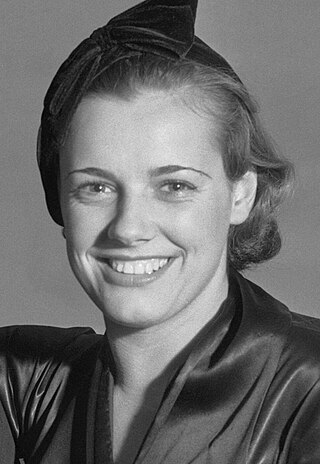
Eleanor G. Holm was an American competition swimmer and Olympic gold medalist. An Olympian in 1928 and 1932, Holm was expelled from the 1936 Summer Olympics team by Avery Brundage under controversial circumstances. Holm went on to have a high-profile career as a socialite and interior designer and co-starred in a Hollywood Tarzan movie, Tarzan's Revenge.

Esther Jane Williams was an American competitive swimmer and actress. She set regional and national records in her late teens on the Los Angeles Athletic Club swim team. Unable to compete in the 1940 Summer Olympics because of the outbreak of World War II, she joined Billy Rose's Aquacade, where she took on the role vacated by Eleanor Holm after the show's move from New York City to San Francisco. While in the city, she spent five months swimming alongside Olympic gold-medal winner and Tarzan star Johnny Weissmuller. Williams caught the attention of Metro-Goldwyn-Mayer scouts at the Aquacade. After appearing in several small roles, and alongside Mickey Rooney in an Andy Hardy film and future five-time co-star Van Johnson in A Guy Named Joe, Williams made a series of films in the 1940s and early 1950s known as "aquamusicals", which featured elaborate performances with synchronised swimming and diving.
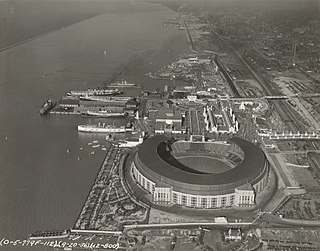
The Great Lakes Exposition was held in Cleveland, Ohio, in the summers of 1936 and 1937, along the Lake Erie shore north of downtown. The fair commemorated the centennial of Cleveland's incorporation as a city. Conceived as a way to energize a city hit hard by the Great Depression, it highlighted the progress that had been achieved in the Great Lakes region in the last 100 years and indicated the path for future progress. Covering over 135 acres of Cleveland's lakefront, it featured numerous attractions, including rides, sideshows, botanical gardens, cafes, art galleries, and much more. Similar to the Chicago World's Fair, the exposition also wanted to expose visitors to other countries' cultures, celebrate American industry, and promote local businesses. Although the Great Lakes Exposition was not as much of a world fair as the Chicago World's Fair was, the exposition drew 4 million visitors in its first season, and 7 million by the end of its second and final season in September 1937—a total of 13 million visitors.
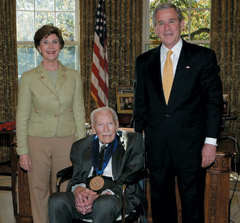
Viktor Schreckengost was an American industrial designer as well as a teacher, sculptor, and artist. His wide-ranging work included noted pottery designs, industrial design, bicycle design and seminal research on radar feedback. Schreckengost's peers included designers Raymond Loewy, Norman Bel Geddes, Eva Zeisel, and Russel Wright.

The Golden Gate International Exposition (GGIE) (1939 and 1940), held at San Francisco's Treasure Island, was a World's Fair celebrating, among other things, the city's two newly built bridges. The San Francisco–Oakland Bay Bridge opened in 1936 and the Golden Gate Bridge in 1937. The exposition opened from February 18, 1939, through October 29, 1939, and from May 25, 1940, through September 29, 1940; it drew 17 million visitors to Treasure Island.

Dorothy Ford was an American actress and model active from the 1940s through the 1960s.
János "Johnny" Weissmüller Jr. was an American actor and longshoreman. He also authored a book about his father, the five-time Olympic Games gold medalist Johnny Weissmuller, who achieved additional fame playing the title role in the Tarzan movies of the 1930s and 1940s.

John Murray Anderson was a Canadian theatre director and producer, songwriter, actor, screenwriter, dancer and lighting designer, who made his career in the United States, primarily in New York City and Hollywood. He worked in almost every genre of show business, including vaudeville, Broadway, and film. He also directed plays in London.

The Earl Carroll Theatre was a Broadway theatre at 753 Seventh Avenue near 50th Street in the Theater District of Midtown Manhattan in New York City. Built by impresario Earl Carroll and designed by architect George Keister, it opened on February 25, 1922, and was highly successful for a number of years until it was demolished and rebuilt on a lavish scale. It reopened in August 1931 with Carroll's billing that it was "the largest legitimate theater in the world." However, the facility's operating costs proved astronomical and it went into foreclosure in early 1932 after which it was acquired by producer Florenz Ziegfeld who renamed it the Casino Theatre. The Casino was the site of a very successful revival of Ziegfeld's production of Show Boat in 1932. However, Ziegfeld too went bankrupt only a short time later. The property was auctioned in foreclosure on August 18, 1933 to the Mutual Life Insurance Company for $1 million.
Marshall Wayne was an American diver who competed in the 1936 Summer Olympics.
Theodore Fetter was a Broadway lyricist who contributed material to such revues as The Show Is On (1936) and Billy Rose's Aquacade (1939), but is best remembered for co-writing the song "Taking a Chance on Love," introduced in the 1940 musical comedy Cabin in the Sky.

Art in Action was an exhibit of artists at work displayed for four months in the summer of 1940 at the Golden Gate International Exposition (GGIE) held on Treasure Island. Many famous artists took part in the exhibit, including Dudley C. Carter, woodcarver and Diego Rivera, muralist. Rivera painted his monumental work Pan American Unity at Art in Action.
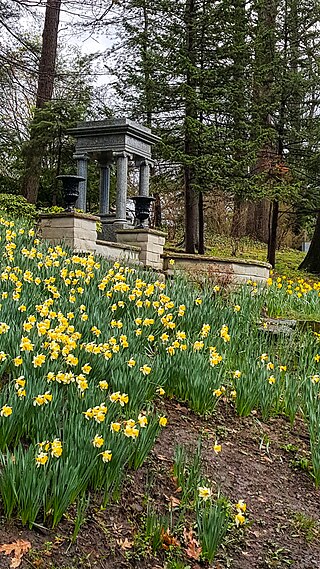
Lake View Cemetery is a privately owned, nonprofit garden cemetery located in the cities of Cleveland, Cleveland Heights, and East Cleveland in the U.S. state of Ohio. Founded in 1869, the cemetery was favored by wealthy families during the Gilded Age, and today the cemetery is known for its numerous lavish funerary monuments and mausoleums. The extensive early monument building at Lake View helped give rise to the Little Italy neighborhood, but over-expansion nearly bankrupted the burial ground in 1888. Financial recovery only began in 1893, and took several years. Lake View grew and modernized significantly from 1896 to 1915 under the leadership of president Henry R. Hatch. The cemetery's cautious management allowed it to avoid retrenchment and financial problems during the Great Depression.
Edris Eckhardt was an American artist associated with the Cleveland School. She is known for her work in Ceramic art and glass sculpture, her work with the Works Projects Administration's (WPA) Federal Arts Project of Cleveland, and her teaching.

Gaylon Wesley Smith was a professional American football back and defensive end who played five seasons for the Cleveland Rams in the National Football League (NFL) and one season for the Cleveland Browns of the All-America Football Conference (AAFC). Before entering professional football, Smith starred as a halfback at Rhodes College and led the country in scoring in 1938. He was selected by the Rams in the second round of the following season's NFL draft and played for the Cleveland team until deciding to retire from the sport in 1943. After taking a job as a personnel director and playing on a regional basketball and baseball teams based in the Cleveland area, Smith joined the U.S. Navy in 1944 during World War II. He was discharged two years later and signed with the Browns, then a new team in the AAFC. Smith was a second-string player with the Browns but substituted for an injured Marion Motley late in the season as the team won the AAFC championship game. Smith retired after the 1946 season but stayed in Ohio to raise his family and work as a manufacturer's representative. He died in 1958 at the age of 41.

There have been several nicknames for the City of Cleveland throughout its history. These include:
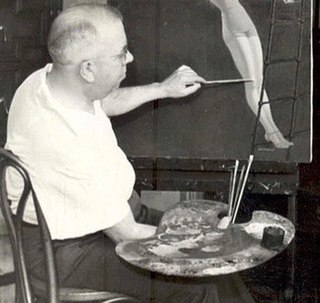
Edward Mason Eggleston was an American painter who specialized in calendar portraits of women, fashionable and fantastic. He was also a well known commercial illustrator doing work for companies such as the Fisk Tire Company, the Pennsylvania Railroad, and the Great Lakes Exposition.
















